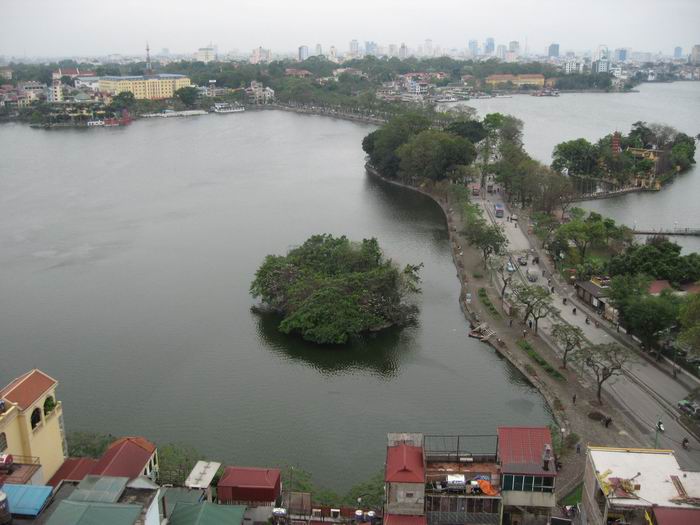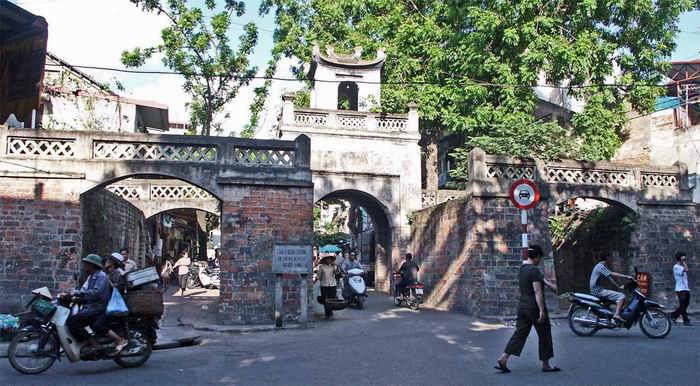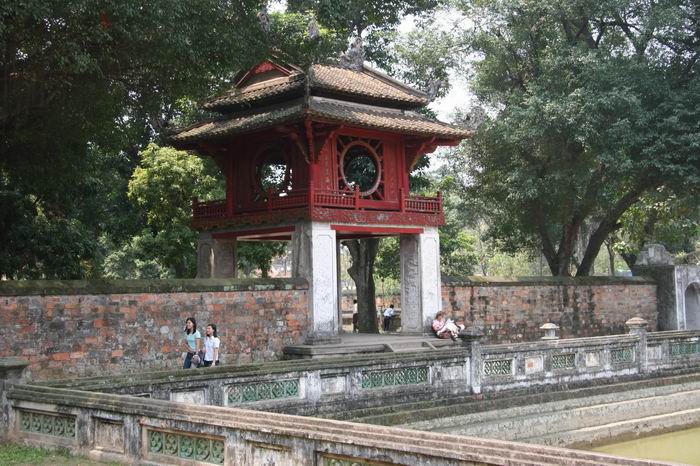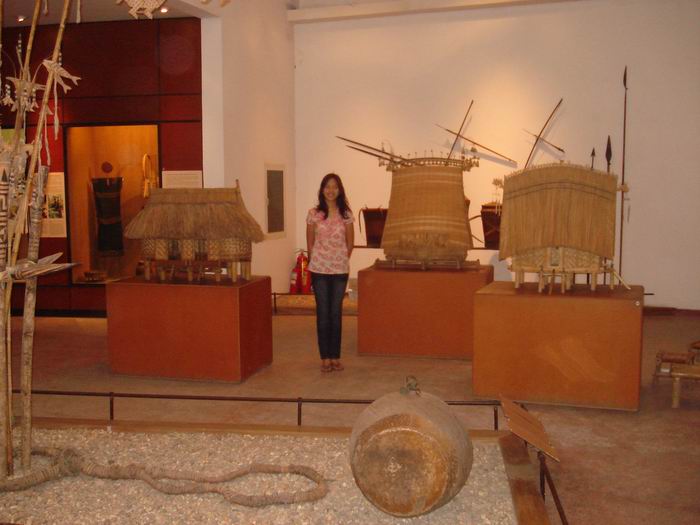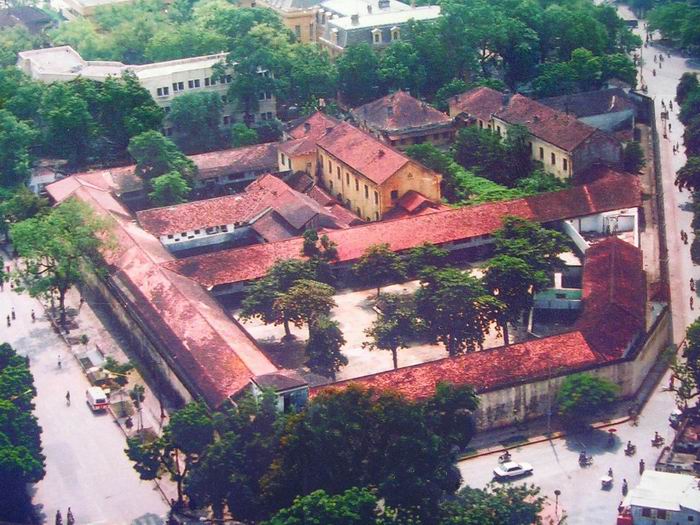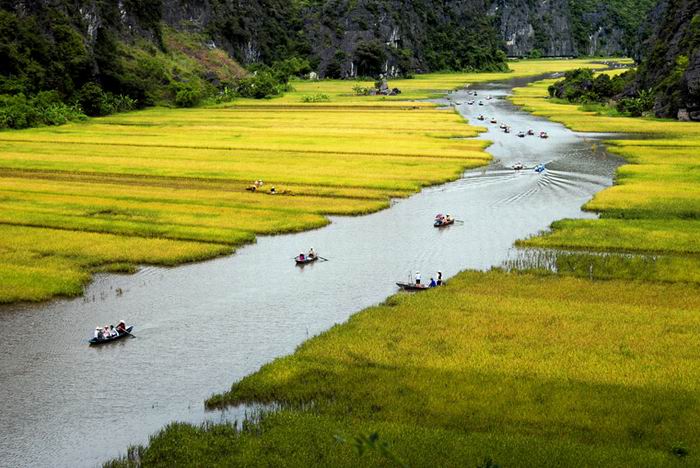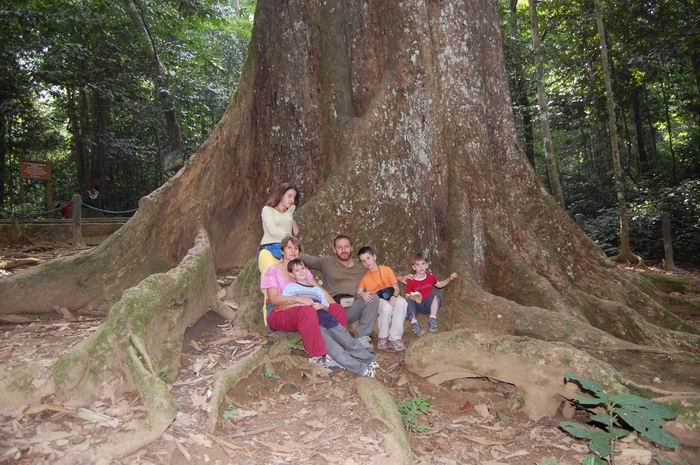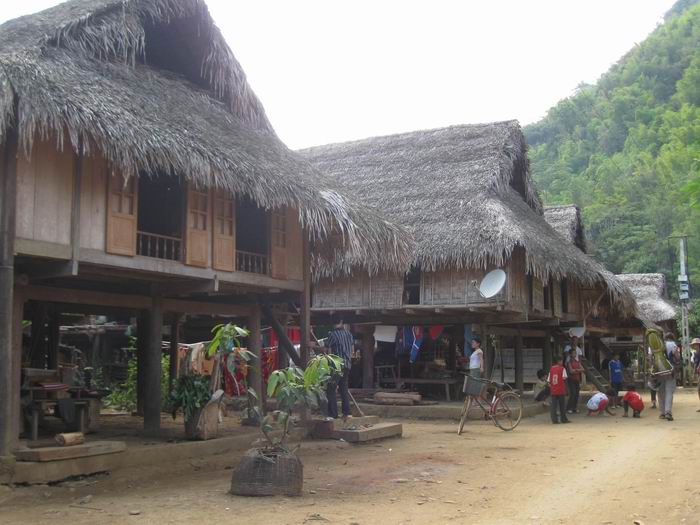Imagine a city where the exotic chic of old Asia blends with the dynamic face of new Asia Where the medieval and modern co-exist. A city with a blend of Parisian grace and Asian pace, an architectural museum piece evolving in harmony with its history, rather than bulldozing through like many of the region's capitals. Hanoi is where imagination becomes reality. A mass of motorbikes swarm- through the tangled web of streets that is the Old Quarter, a cauldron of commerce for almost 1000 years and still the best place to check the pulse of this resurgent city.
Hawkers in conical hats ply their wares, locals sip coffee and bia hoi (beer) watching life (and plenty of tourists) pass them by- Witness synchronised tai chi at dawn on the shores of Hoan Kiem Lake while goateed grandfathers tug at their wisps over the next chess move. See the bold and beautiful dine at designer restaurants and cut the latest moves on the dance floor. Hanoi has it all: the ancient history, a colonial legacy and a modern outlook. There is no better place to untangle the paradox that is modern Vietnam. The grand old dame of Asia, Hanoi lay in a deep slumber after Vietnam's partition in 1954 until the effects of economic reforms kicked in four decades later- The city survived American bombs and Russian planners to emerge relatively unscathed in the early 1990s as an example of a French-conceived colonial city. Huge mansions line grand boulevards, and lakes and parks dot the city, providing a romantic backdrop to the nonstop soundtrack. There are still moments of Paris, as the smell of baguettes and cafe au lait permeates street corners. Known by many names down the centuries, Thang Long (City of the Soaring Dragon) is the most evocative, and let there be no doubt that this dragon is on the up once rnore
SIGHTS
Old Quarter
This is the Asia we dreamed of from afar. Steeped in history,
pulsating with life, bubbling with commerce, buzzing with
motorbikes and rich in exotic scents, the
Old Quarter is Hanoi's
historic heart. The streets are narrow and congested, and
crossing the road is an art form, but remember to look up as
well as down, as there is some elegant old architecture in and
among the chaos. Hawkers pound me streets, sizzling and smoking
baskets hiding a cheap meal for the locals
Pho stalls and bia
hoi dens hug every corner, resonant with the sound of gossip and
laughter Modern yet medieval, there is no better way to spend
time in Hanoi than walking the streets. Soaking up the sights,
sounds and smelts. Home to a thousand years of history, the
commercial quarter of the city evolved along side the Red River
and the smaller To Lich River, which once flowed through [he
city centre in an intricate network of canals and waterways,
teeming with boats. Waters could rise as high as 8m during the
monsoon. Dikes were constructed to protect the city and these
can still be seen along Tran Quang Khai. In the 13th century
Hanoi's 36 guilds established themselves here, each taking a
different street - hence the original name '36 Streets'.
Today,
there are more than 50 streets in today's Old Quarter. Hang
means ‘merchandise’ and is usually followed by the name of the
product that was traditionally sold in that street .Thus, Pho Hang
Gai translates as ‘Silk Street’ (see the boxed text for the
rest), these days the street name may not indicate what’s sold
there, otherwise there would be lost of Pho Hang Du Lich
(Tourism Streets Exploring the maze of back -streets is fascinating: some streets open up while others narrow into a warren
of alleys. The area is known for its tunnel (or tube) houses -so
called because of their narrow frontages and long rooms. These
tunnel houses were developed to avoid taxes based on the width
of then street frontage By feudal law, houses were also limited
to two storeys and, out of respect for the king, could not be
taller than the Royal Palace. These days there are taller
buildings, but no real high-rise buildings. Opportunities to
dispense with your dong are endless. As you wander around you'll
find clothes, cosmetics, fake sunglasses, luxury food, T -
shirts, musical instruments, plumbing supplies, herbal
medicines, jewellers', religious offerings, spices, woven mats
and much, much more. Some of the specialised streets include Pho
Hang Quat, with its red candlesticks, funeral boxes, flags and
temple items; and the more glamorous Pho Hang Gai, with its
silk, embroidery, lacquer-ware, paintings and water puppets -
silk sleeping-bag liners and! elegant ao dai (the national dress
of Vietnam) are popular here. Finally, no trip to the Old
Quarter would he complete without a visit to the
Dong Xuan Market (Pho Hang Khoai & Pho Dong Xuan),
rebuilt after a fire in 1994. A stroll through the historic Old
Quarter can last anywhere from an hour to the better part of a
day, depending on your pace. However long, or whatever detours
you might take. the Walking Tour will provide you with a heady
dose of Vietnamese culture, lots of shopping opportunities and
some insight into the city's long history.
HO CHI MINH'S MAUSOLEUM
In the tradition of Lenin and Stalin before him - and Mao
afterwards -
Ho Chi Minh's Mausoleum is a monumental marble edifice that is a mecca
for many Vietnamese. Contrary to his desire for a simple
cremation, the mausoleum was constructed of native materials
gathered from all over Vietnam between 1973 and 1975. The roof
and peristyle are said to evoke either a traditional communal
house or a lotus flower, though to many tourists it looks like a
concrete cubicle with columns. Set deep in the bowels of the
building in a glass sarcophagus is the body of Ho Chi Minh. The
mausoleum is closed for about three months each year while Ho
Chi Minh's embalmed corpse goes to Russia for maintenance. Some
-sceptics have suggested Madame Tussaud's lias the contract
these days. The queue, which moves quite quickly, usually snakes
for several hundred metres to the mausoleum entrance itself.
Inside, more guards, regaled in snowy-white military uniforms,
are posted at intervals of five paces giving an eerily
authoritarian aspect to the slightly macabre spectacle of the
embalmed body with its wispy while hair. The following rules are
strictly applied to all visitors to the mausoleum:
People wearing shorts, tank tops and so on will not be admitted.
Nothing (including day packs, cameras and mobiles) can be taken
inside. Maintain a respectful demeanour at all times: no talking
or sniggering For obvious reasons of decorum, photography is
absolutely prohibited inside the mausoleum. It is forbidden to
put your hands in your pockets. Hats must be taken off inside the
mausoleum building. Most of the visitors are Vietnamese and
it's interesting to watch their reactions. Most show deep
respect and admiration for Ho Chi Minh, who is honoured for his
role us the liberator of the Vietnamese people from colonialism,
as much as for his communist ideology. This view is reinforced
by Vietnam’s educational system, which emphasises Ho’s deeds and
accomplishments. If you're lucky, you’ll catch the changing of
the guard outside Ho's mausoleum - the pomp and ceremony
displayed here rivals she British equivalent at Buckingham
Palace. Photography is permitted outside the building but not
inside and visitors must leave their bags and mobile phones at a
counter just inside the entrance.
ONE PILLAR PAGODA
A Hanoi landmark, the
One Pillar Pagoda
(Chua Mot Cot; Pho Ong Ich Kiem) was built by the Emperor Ly
Thai Tong, who ruled from 1028 to 1054. According to the annals,
the heirless emperor dreamed that he had met Quan The Am Bo Tat,
the Goddess of Mercy, who, while seated on a lotus flower,
handed hi in a male child. Ly Thai Tong then married A young
peasant girl and had a son and heir in- her. As a way of
expressing his gratitude for this event, he constructed this
pagoda in 1049 The delicate One Pillar Paged; built of wood on a
single stone pillar, is designed to resemble a lotus blossom,
the .symbol of purity, rising out ot a sea of sorrow. One of the
last (malicious and pointless) acts of the French before
quitting Hanoi in 1954 was to destroy the original One Pillar
Pagoda; the structure was rebuilt by the new government. The
pagoda is between the mausoleum and the museum.
TEMPLE OF LITERATURE
A rare example of well-preserved traditional Vietnamese
architecture, the
Temple of Literature is a relaxing retreat from the noisy streets of
Hanoi. If you only plan to visit one temple m Hanoi, be sure to
make it this one It was founded in 1070 by Emperor Ly Thanh
Tong, who dedicated it to Confucius (Khong Tu) in order to
honour scholars and men of literary accomplishment. Vietnam's
first university was established here in 1076 to educate the
sons of mandarins In 1484 Emperor Le Thanh Tong ordered that
stelae be erected to record the names, places of birth and
achievements of men who received doctorates in triennial
examinations held from 1442. Although 116 examinations were held
between 1442 and 1778, when the practice was discontinued, only
82 stelae are extant. In 1802 Emperor Gia Long transferred the
National University to his new capital. Hue. Major renovations
were earned out here in 1920 and 1956. The Temple ot Literature
is made up of five separate courtyards. The central pathways and
gates between them were reserved for the king. The walkways on
one side were for the use of administrative mandarins, while
those on the other side were for military mandarins. The main
entrance is preceded by a gate, on which there's an inscription
requesting that visitors dismount their horses before entering.
Make sure you do. Khue Van Pavil ion, at the far side of the
second courtyard, was constructed in 1802 and is a fine example
of Vietnamese architecture. The 82 stelae, considered to be the
most precious artefacts in the temple, are arrayed to cither
side ot the third enclosure; each one sits on a stone tortoise.
The secular intrudes on the spiritual these. days, with a host
of souvenir shops flank ing the Thai Hoc courtyard. Everything
from postcards to retired water puppets arc avail able but
bargain hard as prices are high. The Temple of Literature is
about 2km west of Hoan Kiem Lake.
NGOC SON TEMPLE
Founded in the 18th century,
Ngoc Son
Temple is
on an island in the northern part of Hoan Kiem Lake. Surrounded
by water and shaded by trees, it is a delightfully quiet place
to escape the bustle of Hanoi. The temple is dedicated to the
scholar Van Xuong, General Tran Hung Dao, who defeated the
Mongols in the 13th century, and La To, the patron saint ot
physicians. Ngoc Son Temple is reached via the red The Hue
(Rising Sun) Bridge, constructed in 1885. The nearby
Martyrs' Monument was erected to those who died fighting !or
Vietnam's independence,
AMBASSADORS' PAGODA
The official centre of Buddhism in Hanoi. the
Ambassadors' Pagoda (Chua Quan Su;
Tell: 825 2427; 73 Pho Quan Su) attracts quite a crowd on
holidays. During the 17th century there was a guesthouse here
for the ambassadors of Buddhist countries- Today there are about
a dozen monks and nuns based at the Ambassadors' Pagoda- Next to
the pagoda is a shop selling Buddhist ritual objects. The
Ambassadors' Pagoda is located be tween Pho Ly Thuong Kiet and
Pho Tran Hung Dao.
QUAN THANH TEMPLE
Shaded by huge trees,
Quan Thanh Temple
was established during the Ly dynasty (1010-1225) and was
dedicated to Tran Vo (God of the North), whose symbols of power
were the tortoise and the snake. A bronze statue and bell date
from 1677. The temple is on the shores of Truc Bach Lake, near
the intersection of ?? Thanh Nien and Pho Quan Thanh.
TAY HO PAGODA
The most popular spot for worship in Hanoi is at
Tay Ho Pagoda ( Phu lay Ho).
Throngs of people come here on the first and 15th day of each
lunar month in the hope of receiving good fortune. The entrance
includes a col ourful lane of stalls selling temple offerings
and food, while a line of good fresh seafood restaurants fronts
the lake. It's a great place to watch the world go by.
TRAN QUOC PAGODA
One of the oldest in Vietnam, Tran Quoc
Pagoda is on the eastern shore of Ho Tay, just off ??
Thanh Nien, which divides Ho Tay from True Bach Lake. A stele
here, dating from 1639, tells the history of this site. The
pagoda was rebuilt in the 15th century and again in 1842. There
are a number of monks' funerary monuments in the garden.
VIETNAM MUSEUM OF ETHNOLOGY
The Musee de FHomme in Paris helped design the wonderful
Vietnam Museum of Ethnology. It features a fascinating collection of.irt and everyday objects gathered from Vietnam and its
diverse tribal people. The museum lias excellent maps and the
displays are well labelled in Vietnamese, Fench and English.
Interesting sections portray a typical village market, the
making of conical hats, and a Tay shamanic ceremony while videos
show the real-life contexts. There are fabulous displays of
weaving and fabric motifs. Visitors can also enter a traditional
Black Thai house reconstructed within the museum, and there are
outdoor exhibits in [lie landscaped grounds. Ede, H'mong and
Jarai houses are popular places to pose for wedding photos;
quite a surreal sight. There are often special exhibitions,
including the current display on life in the early 1980s under
the- coupon system. This could become a permanent feature, as it
is so well presented and surprisingly honest about the hardships
of life at the time. A craft shop - affiliated with Craft Link,
which is a fair-trade organisation - sells books, beautiful
postcards, and arts and crafts from
ethnic communities. The
museum is quite a way from central Hanoi, but it shouldn't be
missed
HISTORY MUSEUM
A must for the architecture more than the collection, the
History Museum was formerly home to the Ecole Francaise d'Extreme
Orient in Vietnam. It is an elegant, ochre-coloured structure
built between 1925 and 1932. French architect Ernest Hebrard was
among the first in Vietnam to incorporate a blend of Chinese and
French design elements in his creations, and this particular
building remains one of Hanoi's most stunning architectural
showpieces. Collections here cover the ups more than the downs
of Vietnamese history. Highlights include some excellent bronzes
from the Dong Son culture (3rd century BC to 3rd century AD) and
some striking Hindu statuary from the Khmer and Champa kingdoms.
More recent history is a little one-sided and includes the
struggle against the French and the story of the Communist
Party,
MUSEUM OF VIETNAMESE REVOLUTION
A must for all budding revolutionaries, the history of the
Vietnamese Revolution is enthusiastically presented in this
museum. It's
diagonally across the road from the History Museum.
MEMORIAL HOUSE
It is worth making a detour to this delightful
house, north of Hoan Kiem Lake in the Old
Quarter. This thoughtfully restored traditional Chinese-style
dwelling is sparsely but beautifully decorated, and offers a
bygone glimpse into the lives of local merchants in the Old
Quarter. The restoration of the house was carried out in 1999 in
cooperation with the city of Toulouse, France. While there are
many such living museums in Hoi An, there is nothing else like
this in Hanoi.
FINE ARTS MUSEUM
The former French Ministry of Information is home to
Hanoi's
Fine Arts Museum. The collection here
includes some very intricate sculptures, paintings, lacquerware,
ceramics and other traditional Vietnamese fine arts. It's a good
starting point for anyone seriously considering investing in
Vietnamese art. Reproductions of antiques are on sale here, but
be sure to ask for a certificate to clear these goods through
customs when you leave Vietnam. The Fine Arts Museum is on the
coiner of Pho Cao Ba Quat, across the street from the northern
wall of the Temple of Literature.
ARMY MUSEUM
Easy to spot thanks to a large collection ui weaponry out
front, the
Army Museum displays Soviet and
Chinese equipment alongside French and US-made weapons captured
during years of warfare. The centre piece is a Soviet-built
MiG-21 jet fighter, triumphant amid the wreckage of French
aircraft downed at Dien Bien Phu, and a US F- 111. The displays
include scale models of various epic battles from the long
military history of Vietnam, including Dien Bien Phu and the
capture of Saigon. Next to the Army Museum is the hexagonal Flag
Tower, which has become one of the symbols of Hanoi.
HOA LO PRISON MUSEUM
This thought-provoking site is all that remains of the former
Hoa Lo Prison, ironically nicknamed the 'Hanoi Hilton' by
US POWs during the American War. Those incarcerated at Hoa Lo
included Pete Peterson, who later became the first US Ambassador
to a unified Vietnam in 1995, and Senator john McCain. The vast
prison complex was built by the French in 1896. Originally
intended to house around 450 inmates, records indicate that by
the 1930s there were close to 2000 prisoners. Much of the prison
was razed to make room for the Hanoi Towers skyscraper, though
the section at the front of the site has been thoughtfully
preserved and restored as a museum - look for the sign over the
gate reading 'Maison Centrale'. There are some English and
French labels corresponding with the displays, and it is
possible to find an English speaking guide on site. The bulk of
the exhibits here relate to the prison's use up to the
mid-1950s, focusing on the Vietnamese struggle for independence
from France. Notable gruesome exhibits in the dark chambers
include an ominous French guillotine that was used to behead
Vietnamese revolutionaries during the colonial period, and the
fetters with which prisoners were chained to the bunks. Even
allowing for the propaganda, it looks like the treatment of
Americans by the Vietnamese was infinitely better than that of
Vietnamese nationalists by the French. There are also mug shots
on display of Americans and Vietnamese who served time at Hoa
Lo. Missing in Action (M1A) teams continue to search for remains
of missing US air personnel all over Vietnam.
HOAN KIEM LAKE
The epicentre of old Hanoi, Hoan Kiem Lake
is an enchanting body of water. Legend has it that, in the
mid-15th century, Heaven sent Emperor Le Thai To (formerly Le
Loi) a magical sword, which he used to drive the Chinese out of
Vietnam. One day after the war he happened upon a giant golden
tortoise swimming on the surface of the water; the creature
grabbed the sword and disappeared into the depths of the lake.
Since that time, the lake has been known as Ho Hoan Kiem (Lake
of the Restored Sword) because the tortoise restored the sword
to its divine owners. Ngoc Son Temple
sits on an island near the northern end of Hoan Kiem Lake. The
ramshackle Thap Rua (Tortoise Tower), on an islet near the
southern end of the lake, is lopped with a red star and is often
used as an emblem of Hanoi, Early risers should make for the
lake, as every morning around 6am local residents can be seen
doing their traditional t'ai chi on the shore. It's a graceful
sight, plus there are joggers and games of badminton.
HO TAY (WEST LAKE)
The largest lake in Hanoi - about 13km in circumference- the
shores of HoT ay are fast developing
a reputation as a desirable place to live for those that can
afford the luxury villas. To the south of the lake, along ?? Thuy
Khue, there's a string of popular seafood restaurants that are
de rigeur for a local night out. To the east are some luxury
hotel and an emerging enclave of restaurants, bars and
boutiques. The rest is mainly residential. Two legends explain
the origins of Ho 'lay, which is also known as the Lake of Mist
and the Big Lake. According to one legend. Ho Tay was created
when the Dragon King drowned an evil nine-tailed fox in his
lair, which was in a forest on this site. Another legend relates
that in the 11th century a Vietnamese Buddhist monk, Khong Lo,
rendered a great service to the emperor of China, who rewarded
him with a vast quantity of bronze from which he cast into a
huge bell. The sound of the bell could be heard all the way to
China, where the Golden Buffalo Calf, mistaking the ringing for
its mother's call, ran southward, trampling on the site of Ho
Tay and turning it into a lake. The geological explanation is
that the lake-was created when Song Hong (Red River) overflowed
its hanks. The flood problem has been partially controlled by
building dikes And the highway along the eastern side of Ho Tay
is built upon one.
THE TORTOISES OF HOAN KIEM LAKE: FACT OR
FICTION?
Unbelievably, there ore tortoises in the mysterious and murky
waters of Hoan Kiem Lake. Surfacing on rare occasions, and
bringing luck to anyone fortunate enough to see one. the Sword
Lake tortoise (Rafetus leloii) is not just your common
garden-variety tortoise: it is a huge beast. A specimen that
died in 1968 weighed in at 250kg and was 2.1m long! Its
preserved remains are on show in the Ngoc Son Temple complex.
together with a photo taken of a tortoise that appeared in the
lake in 2000. No-one is sure how many there still are, or how
they have survived in this urban setting. Rumours abound. Are
these really the lake-dwelling descendants of the golden
tortoise of Le Thai To? Or are they safeguarded in enclosures
elsewhere and transported to the lake from time to time, where
their occasional appearance is simply an orchestrated ploy to
keep the legend of the lake alive? Those ripples on the lake
surface will never seem so innocent again.
OLD QUARTER STREET NAMES
street name.........description................streetname............description
Bat Dan.............. wooden bowls..........Hang
Giay..............paper or shoes
BatSu.................china bowls..............Hang
Hanh.............onions
ChaCa................roasted fish...............Hang
Hom............. cases
Chan Cam..........string instruments......Hang Huong...........
mcense
Cho Gao.............rice market...............Hang
Khay.............trays
Gia Ngu..............fishermen.................Hang
Khoai............sweet potatoes
Hai Tuong...........sandals....................Hang
Luoc............ combs
Hang Bac...........silversmiths...............Hang
Ma............... votive papers
Hang Be.............rafts.........................Hang
Main..............pickied fish..
Hang Bo........... .baskets....................Hang
Manh.............bamboo screens
Hang Bong..........cotton......................Hang
Muoi..............salt
Hang Buom........sails........................ Hang
Ngang............transversal street
Hang But............brushes....................Hang
Non...............hats
Hang Ca.............fish..........................Hang
Phen..............alum
Hang Can...........scales..................... Hang
Quat..............fans
Hang Chai..........bottles..................... Hang
Ruoi...............dam worms
Hang Chi............threads.....................Hang
Than..............charcoal
Hang Chieu........mats........................ Hang
Thiec.............tin
Hang Chinh.........jars..........................Hang
Thung............barrels
Hang Cot............bamboo lattices........Hang
Tre................bamboo
Hang Da.............leather.....................Hang
Trong.............drums
Hang Dao...........(silk) dye's................Hang
Vai................cloth
Hang Dan...........beans or
oils............LoRen.....................blacksmiths
Hang
Dieu..........pipes.......................LoSu......................coffins
Hang
Oong.........copper....................MaMay...................rattan
Hang Ouong.......sugar......................Ngo
Gach............... bricks
Hang da.............chicken..................Thuoc
Bac...............herbal medicines
Hang Gai............siik
AROUND NINH BINH
Tam Coc:
Poetically penned "Halong Bay on the rice
paddies', the area around
Tam Coc boasts stunning scenery. While
Halong Bay has rugged rock formations jutting out of the sea
here they soar skywards from a sea of green, 'Tam Coc (entry fee
30,000d,boat 40,000d) is named after the low caves through which
the Ngo Dong River flows. The essential Tam Coc experience is So
sit back and be rowed through the
caves - a serene and scenic
trip, which turns into a surreal dance towards the end. The
boats carry two people as well as the main rower at the rear and
a secondary rower, usually an elderly woman, whose purpose
becomes clear at the end of the journey. Hang Ca, the first
cave, is 127m long; Hang Giua 70m long; and the thirds Hang Cuoi,
is only 45m. The boat trip takes about two hours and tickets are
sold at the small booking office by the car park. Even on cloudy
days, bring sunscreen and a hat or umbrella, as there s no shade
in the boats. It pays to arrive early in the morning or late in
the afternoon to avoid the day-tripping crowds from Hanoi. The
area behind the Tam Coc restaurants is Van Lan village, which is
famous for its embroidery. Here local artisans make napkins,
tablecloths, pillowcases and T-shirts. A lot of these items wind
up being sold on Hanoi’s Pho Hang Gai , but it is cheaper to buy
them here directly from the artisan. The village has a much
better selection and slightly Sower prices than those available
from the boat vendors.
BICH DONG PAGODA
This charming cave pagoda is just a couple of kilometres north
ot Tam Coc and worth a visit if you have your own wheels. The
scenic road winds through rice fields hemmed in by karsts and
ends in a dusty village. Bich Dong (Jade Grotto) is cut into the
cave of a karst and is a holy site of pilgrimage for Vietnamese.
The smoke of burning incense and the gloom of the caves give
this place an unearthy atmosphere
Hoa Lu:
Hoa Lu was the capital of
Vietnam during the Dinh (968-80) and early Le (980-1009)
dynasties. The site was a smart choice for a capital city
because of the natural protection afforded by the region's
bizarre landscape, with rocky outcrops as spectacular as Tam
Coc's. the
ancient citadel of Hoa Lu (admission 10,000d), most
of which has been destroyed. covered an area of about 3 sq km.
The' outer ramparts encompassed temples, shrines and the king's
palace. The royal family lived in the inner citadel. Yen Ngua
Mountain provides a scenic back drop for Hoa Lu's two remaining
temples. The first, Dinh Tien Hoang, was restored in the 17th
century and is dedicated to the Dinh dynasty. At the front of
the main temple building is the stone pedestal of a royal
throne: inide are bronze bells and a statue of Emperor Dinh Tien
Hoang with his three sons. In a building to the right a display
features photos and some-artefacts, while to the left are three
Buddhist prayer stones - one supported by a turtle another with
a crab and two rats at the base The second temple is dedicated
to Le Dai Hanh, an early Le monarch. Inside the main hall are an
assortment of drums, gongs, in cense burners, candle holders and
weapons with a statue of the king in the middle, his queen on
the right and their son on the left In the left-hand section of
this complex a modern museum features part of the excavations of
the 10th-century citadel wall, unearthed in 1998 Once you've
navigated the hassle of persistent sellers on the way in, it's
very peaceful inside the complex, especially in the early
morning or late afternoon when the crowds head back to Hanoi. On
the hillside above the temples is the tomb of Dinh Tien Hoang.
It's a good 15-minute climb up 207 steps, hut your efforts will
be rewarded with great views.
The village of
Kenh Ga (Chicken Canal) gets its name,
apparently, from the number of wild chickens that used to live
here. It's a lovely area, and one of the best places outside of
the
Mekong Delta to see river life - but nowhere in the Delta
will you find stunning limestone formations like the ones
providing the backdrop here. Another difference: people in Kenh
Ga row boats with their feet, leaning back and watching the
world go by. The local people seem to spend most of their lives
on or in the water: at their floating fish-breeding pens,
harvesting river grass used for fish feed, trawling in the muddy
shallows for shellfish or selling veggies boat-to-boat. Even the
children commute to school by boat. The river is used for
everything from bathing, to washing plucked chickens, lo
defecating in.
Until recent years this was largely a floating village, with
just a few permanent buildings on the riverbanks. You'll still
see some tiny wooden shelters on boats where the poorest of the
poor live. However, as fortunes improve, people aim to stake
their claim on solid ground. From the pier you can hire a
motorboat to take you for an hour or so
touring around the village.
Van Long Nature Reserve:
Set amid yet more ot the limestone pinnacles that characterise
this region. Van Long (entry 20,000(1) is a reedy wetland that
attracts the birds. It's become a popular spot for inter
national birdwatchers keen for a sighting of a rare black-faced
spoonbill, a cotton pygmy goose, a white-browed crake or other
fantastically named feathery fauna- The fee includes a punt
through the shallow waters and, with your eyes peeled, you just
might see a Dela-cour's langur monkey lurking in the outcrops
Van Long can be easily combined with a visit to Kenh Ga and, at
a stretch, both can be visited en route to
Cuc Phuong National
Park. Van Long is 2km east of Tran Me, a small town 23km from Ninh Binh alone the road to Cuc Phuong.
CUC PHUONC NATIONAL PARK
Established in 1962, Cuc Phuong National
Park is one of
Vietnam's most important protected areas. Ho Chi Minh personally
took time off from the war in 1963 to declare this Vietnam's
first national park, saving: 'Forest is gold. It we know how to
conserve it well, it will be very precious. Destruction of the
forest will lead to serious effects on both life and
productivity. This national park is 70km from the coast and
covers an area about 25km long and 11km wide, spanning the
provinces of Ninh Binh,
Hoa Binh and Thanh Hoa. Its highest peak
is Dinh May Bac (Silver Cloud Peak) at 656m. The park is home to
the excellent Endangered Primate Rescue Center.
The centre is located about 500m before the national park
reception centre. You can't wan-der around the centre alone, so
if you're travelling independently you need first to go to the
national park reception area and arrange a guide. Entry is free,
but you might consider purchasing some postcards or a poster, or
making a donation. Though wildlife has suffered a precipitous
decline in Vietnam in recent decades, the park's 222 sq km of
primary tropical forest remains home to an amazing variety of
ammal and plant life. There are 320 species of bird, 97 species
of mammal including bats, and 36 species of reptile identified
so far. Of the 2000 plant species, 433 have medicinal properties
and 299 are food sources. The park is home to a species of tree
called Cay Kim Gao (Podocarpus fleuryi hickel). In ancient
times. kings and mandarins would only eat with chopsticks made
from this lumber - it was said that anything poisonous it
touches turns the light-coloured wood to black. Poaching and
habitat destruction are a con stant headache for the park
rangers. Many native species, such as the Asiatic black bear.
Siamese crocodile, wild dog and tiger, have vanished from the
area as a result of human impact. Episodes of violence have
erupted between the Muong and park rangers who have tried to
stop logging in the park. The government has responded by
relocating the villagers further from the park's boundary. Some
ecotourism ventures such as
village homestays provide income to
the local people, thereby giving conservation a direct economic
benefit to them. Improved roads have led to increased illegal
logging, which in turn is having a huge impact on the growth,
movement and conservation of plants and animals. The best time
of year to visit the park is in the dry months from November to
February. From April to June it becomes increasingly hot, wet
and muddy, and from July to October the rains arrive, bringing
lots of leeches. Visitors in April and May should be lucky
enough to see some of the literally millions of butterflies that
breed here. There is a low-key, informative visitor centre a few
hundred metres before the park entrance.
MAI CHAU
Mai Chau is the heart of a beautiful valley
that is a world away from the hustle and bustle of Hanoi. The
modern village is an unappealing sprawl, but as you emerge on
the rice fields and rural living it is transformed into a real
paradise. It's a stunning area, and most people here are ethnic
White Thai, distantly related to tribes in Thailand, Laos and
China paradise. It's a stunning area, and most people here are
ethnic White Thai, distantly related to tribes in Thailand, Laos
and China. Although most locals no longer wear traditional
dress, the Thai women are masterful weavers who ensure that
there is plenty of traditional-style clothing to buy in the
village centre. You will see women weaving on looms under or
inside their houses in the village. Much of the silk looks
similar to that seen in Laos. The Thai of Mai Chau are less
likely to employ strong-arm sales tactics than their H'mong
counterparts in Sapa: polite bargaining is the norm rather than
endless haggling.
This is one of the closest places to Hanoi where you can
experience a 'real' Montagnard village. Other attractions here
include staving overnight in one of of the Thai stilt houses, walking
through the beautiful valley through the rice fields and
trekking to minority villages. A
typical trek further afield covers 7km to 8km; a local guide can
be hired for about US$5. There is a popular 18km trek from
Lac village (Ban Lac) in Mai Chau
to Xa Linh village, near a mountain
pass (elevation 1000m) on Hwy 6. Lac village is home to the
While Thai people, while the inhabitants of Xa Linh are H'mong.
The trek is quite strenuous to undertake in a day, so most
people -spend the night in a village along the way. Arrange a
local guide and a car to meet you at the mountain pass for the
journey back to Mai Chau. Be warned that there is a 600m climb
in altitude and the trail can be slippery in the rain, Longer
treks of three to seven days arc pos??sible. Ask around in the
Mai Chau villages of Lac or Pom Coong.
Source: lonely planet






